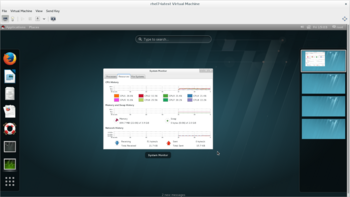I tried using Waydroid on Linux Mint (Edge) only to have it not work and realized that it requires Wayland, and Mint uses X11. So I used VirtualBox to install Fedora 40 Gnome which does use Wayland.
I installed Waydroid as per the instructions and am having seemingly the same issue as on Mint. After downloading “Vanilla” Android and clicking “Done” everything exits out. So I launch the Waydroid application but nothing ever happens.
I then try to manually start Waydroid in terminal but always get “ERROR: WayDroid container service is already running”. Then I skip to the second step “waydroid session start” but receive “OSError: container failed to start”.
Am I doing something wrong? Is it simply because the VM is causing the issues? Or does WayDroid not work well on Fedora? Thanks
If you’re going to run waydroid in a VM, why not just run Android in a VM?
Also why. The. Hell. Are. People. Still. Using. Virtualbox? What is this? 2005? You’re already running a kernel with built in world tier type 1 virtualization.
Also why. The. Hell. Are. People. Still. Using. Virtualbox?
Couldn’t get any Qemu-manager to work (and no time to master running it with scripts) and Vmware can use KVM as hypervisor. Virtualbox not?
No, VirtualBox is a Type 2 hypervisor.
I’m not sure what qemu-manager is, but virt-manager works out of the box on Debian at least. There are no scripts needed, it’s a UI.
use the terminal qemu noob (/s)
Is there an easy way to run Android in a VM?
It’s been a long time since I looked, but I never had great success. The only AMD64 builds I could find were ancient. Getting apps installed was difficult. And my understanding (correct me if I’m wrong) is that Waydroid delivers apps in windows without a whole Android UI around them.
The best option I found was using the Android Studio simulator.
But yeah you won’t get rootless windows obviously. But OP wasn’t going to either running. VM to get waydroid working
Thanks for the link! Latest version is based on Android 13, which is not bad at all.
I’m trying to run blissos now in hyperv with no luck.
Did you make any progress?
I’m trying to find a bluestacks alternative
currently hyper-v has no graphics, qemu reccomended but hyperv should work if you force sofware rendering for gpu
Not really. I tried in AQEMU and also VirtualBox. I got the installer to run, but I never got it to boot into a GUI, either in the LiveCD or installation. Not sure what I’m doing wrong. Maybe I should try the stable 12L build instead of 13.
For now I tried Google play games beta. It’s a type 1 vm instance instead of bluestacks being type 2.
Super easy to setup. At least Google is the one spying on me instead of china.
Also why. The. Hell. Are. People. Still. Using. Virtualbox? What is this? 2005? You’re already running a kernel with built in world tier type 1 virtualization.
Honestly, for me, it’s probably just momentum at this point. I’ve been using Virtualbox for at least 15, maybe 20 years now. I don’t use it much anymore with how good docker, etc. have become. Any recommendation on what I should be using instead?
Qemu, which is the standard KVM front end. Also does emulation when you need other architectures (great for prepping Pi images for example). If you need a UI virt-manager is a UI for libvirt that supports Qemu and lxc (even remotely through ssh). It’s been around since 2009.



Waydroid is made for Wayland.
You can however run it on X-Server,
through a Wayland session window
(e.g. KWin_Wayland, Cage, Weston, …):
https://docs.waydro.id/faq/setting-up-waydroid-only-sessionsI wrote a tool to help improve the user experience on X-Server,
however currently it only supports KDEs Kwin_Wayland:
https://github.com/Rikj000/XWaydroidThis is interesting though at first glance seems a little over my head. I’ll read more into it. Thank you.
PS. This is another comment I can only see and reply to in my inbox. I can’t see it on my post. I don’t know if this is a Lemmy, server, or Voyager issue.
For the record, I’m able to see the comment you responded to.
I have waydroid working great in the latest Mint. You need Weston so Waydroid has a Wayland to connect to.
e: or use the experimental Wayland in 21.3 but it’s not ready for daily driving
Here’s the script I use to start and stop Waydroid:
#!/bin/bash PID=$(pgrep "weston") if [ "$?" -eq "0" ]; then waydroid session stop kill $PID exit fi weston --width=1920 --height=1080 --socket=wayland-1 &>/dev/null & sleep 2 WAYLAND_DISPLAY=wayland-1 XDG_SESSION_TYPE=wayland waydroid show-full-uiChange the resolution to whatever you need it to be. Run it once to start, again to stop. It just lives on my desktop.
I thought about 21.3 but don’t want to use something experimental. What is Weston? It’s good to hear that it works on Mint
Weston is basically Wayland within an X11 app. You can run Wayland stuff with it but it’ll be constrained to that window.
I’ll check that out!
Check out the Waydroid script I posted, it’ll help you with figuring out how to run Wayland programs.
I will. Thank you very much
ArchWiki Waydroid should help you even if you’re not on Arch.
You need a GPU.
First, ditch VirtualBox as it isn’t a type 1 hypervisor. Next setup virtual manager and then enable GPU.
If you need more help let me know.
I will look into this virtual manager. Thanks
I have WayDroid running here with Arch Linux and GNOME without VirtualBox or QEMU. For Arch it requires the zen kernel, or compiling the kernel yourself. https://wiki.archlinux.org/title/Waydroid In the past I had no luck with WayDroid on I think Ubuntu, Debian and what not.
Not sure what issues you had in Debian, works great for me under both testing and Mobian.
Good to know, however I don’t wish to use Arch
WayDroid has a section about VMs, did you see that ? https://docs.waydro.id/faq/get-waydroid-to-work-through-a-vm
I was able to get Waydroid to work in a Debian VM, so unless there’s something weird about how VirtualBox handles things, Waydroid shouldn’t care whether it’s running in a VM or not.
What happens when you run waydroid status or waydroid show-full-ui?
I’m not on my computer currently but I did try show-full-ui. I just remember it didn’t work correctly either. Good to know it can work in a VM though.
PS. I can see your comment in my inbox and reply from there but when I’m on my post your comment doesn’t appear. Some odd Lemmy thing?
PS. I can see your comment in my inbox and reply from there but when I’m on my post your comment doesn’t appear. Some odd Lemmy thing?
I have no idea why that would happen. Probably something weird about Lemmy.
As for Waydroid, it’s kinda finicky in how to start. Use something like btop or ps aux|grep waydroid to check whether you have multiple processes that are all running waydroid session start. It should just be two processes: /usr/bin/waydroid -w container start and /usr/bin/waydroid session start. I remember I had multiple /usr/bin/waydroid -w container start that I had to kill before it worked for the first time.
The devs behind Waydroid also have their own distro set up for Waydroid. You can try that as well: https://waydro.id/#wdlinux
Waydroid works inside of Avian perfectly fine, but I would still generally recommend either just using Bliss OS or the native host. You can run Waydroid using something like Cage or Weston if you’re on X11.
If you are running on something like VirtualBox, you may need to disable hardware acceleration for GPUs. QEMU has working GPU acceleration.
Maybe try disabling SELinux ?







